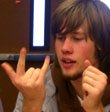
ASL Club practices the sound of silence
Lunch time at the ceramics room attracts a crowd. Amidst the savory smell of curry and amicable chatter that hovers the wooden tables, one of the groups sounds distinctively foreign ━ if sounding applies at all.
For example, instead of saying "banana", a girl is peeling off an imaginary banana with one hand and holding the bottom with the other.
Of course they didn’t always sign to each other; as amateur students of American Sign Language, fragments of English exchange and laughter frequently burst. The American Sign Language (ASL) Club has been meeting every Thursday at lunch in the ceramics room since school started. Its members have been meeting since the second semester of the last school year, but the club was only recently publicized. On the past Club Day, instead of selling food for funds, ASL Club gave away free food items to students who learned to sign two words of their choice from a list from the club’s officers.
"We started the club because we just became interested [in ASL]," co-president junior Lena Jenny said. "Why not?"
With the help of Special Education teacher Michael Lieberman, good friends juniors Lena Jenny and Mahsa Khorramdin organized ASL Club in the spring of 2009. Jenny was first exposed to ASL because her role as Anne Sullivan, Helen Keller’s instructor, in the production "The Miracle Worker", required her to have knowledge of ASL. Khorramdin volunteered to assist since she had taken an ASL class in eighth grade. Jenny and Khorramdin have not stopped the habit of signing with each other as communication since then.
"It’s like a secret language we have. People would be intrigued and ask us what [the signs] meant. And we tell them to join ASL Club if they want to find out," Khorramdin said.
 Jenny and Khorramdin begin the club meeting with teaching vocabulary words. At first,they sign and speak the word verbally at the same time. They also learn by looking up on the Internet words or phrases students request to learn. Another popular activity is singing and signing to simple songs like Taylor Swift’s and the Jonas Brothers’.
Jenny and Khorramdin begin the club meeting with teaching vocabulary words. At first,they sign and speak the word verbally at the same time. They also learn by looking up on the Internet words or phrases students request to learn. Another popular activity is singing and signing to simple songs like Taylor Swift’s and the Jonas Brothers’.
"You can become more part of the song [by signing along] than just sing[ing] along," club member senior Sheiva Khalily said.
ASL intrigued Khalily when she was at her job as a babysitter. The baby she took care of signs to her because he couldn’t speak yet; but Khalily discovered signs and movements are as easily comprehensible as speech.
During a meeting, a passer-by student in the room approached the group and asked Jenny for a very specific favor, to which Jenny replied: "If you learn 10 words, I will teach you two very good curse words." The student walked away.
Art teacher Brian Chow, the club’s adviser, also joined the group for a while. Currently, the group focuses more on building vocabulary. According to Khorramdin, ASL relies heavily on exaggerated emotions and facial expressions. Unlike English, not all words are expressed (signed) in a sentence, which makes signing in a fluent sentence structure a little more challenging.
What attracted Khorramdin to ASL the most was that it allowed her to communicate with all types of people. Khorramdin once encountered a group of hearing-impaired who were signing with each other at the De Anza flea market. She was excited for being able to understand them, however meagerly, and connect with others because of the same language.
"Most people don’t think of sign language when they think of foreign languages. Deaf culture is very specific. If I signed something wrong, they might think it’s offensive. But signing with my friends is fun because [if I signed something wrong], they would be more understanding," Khorramdin said.
In the near future, ASL Club hopes to arrange a service project at a deaf community or to attend a play performed in ASL. Enthusiasm is all it takes for a group of students to put words into action.
{cc-by-nc}








